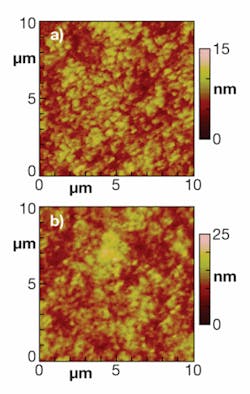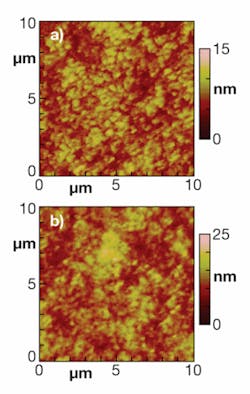Orange-red chromophores produce stable white-emitting OLEDs
White-light organic and polymer light-emitting diodes (WOLEDs and WPLEDs) show promise for use in full-color displays, liquid-crystal-display backlights, and solid-state lighting. These types of diodes work well with a solution-based fabrication process to enable low-cost, homogenous devices on flexible substrates. This motivated scientists at South China University of Technology (Guangzhou, China) to fabricate fluorescent white-emitting devices with a polyfluorene (PFO) host by solution processing. The group synthesized several heterocyclic small molecules that provided orange and red emission when incorporated into PFO, discovering that careful control of the dopant concentration led to efficient white-emitting devices with balanced red-green-blue emissions. An atomic-force microscope was used to image the PFO host alone next to an image of the PFO doped with the molecule 4,7-(2′-diselenophenyl)-2,1,3-benzothiadiozole (SeBT) and 4,7-bis(N-methylpyrrol-2-yl)-2,1,3-benzothiadiozole (PBT). Comparing the host and the hot/blend images shows the dyes mix well with the host polymer and have no dye aggregation. The group obtained very stable narrow-bandgap electroluminescence emission at a wide range of operating voltages. The best white-emitting device produced luminous efficiency of 7.54 cd/A with a luminance over 1000 cd/m2 and an external quantum efficiency of 2.5%. Contact Yong Cao at [email protected].
null

